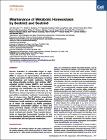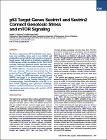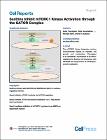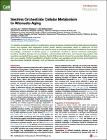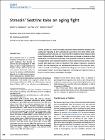Browsing Biochemistry (Scholarly Publications) by Author "Karin, Michael"
Now showing items 1-5 of 5
-
Maintenance of metabolic homeostasis by Sestrin2 and Sestrin3.
Budanov, Andrei; Lee, Jun Hee; Talukdar, Saswata; Park, Eek Joong; Park, Hae Li; Park, Hwan-Woo; Bandyopadhyay, Gautam; Li, Ning; Aghajan, Mariam; Jang, Insook; Wolfe, Amber M.; Perkins, Guy A.; Ellisman, Mark H.; Bier, Ethan; Scadeng, Miriam; Foretz, Marc; Viollet, Benoit; Olefsky, Jerrold; Karin, Michael (2012)Chronic activation of mammalian target of rapamycin complex 1 (mTORC1) and p70 S6 kinase (S6K) in response to hypernutrition contributes to obesity-associated metabolic pathologies, including hepatosteatosis and insulin ... -
p53 target genes sestrin1 and sestrin2 connect genotoxic stress and mTOR signaling
Budanov, Andrei; Karin, Michael (2008)The tumor suppressor p53 is activated upon genotoxic and oxidative stress and in turn inhibits cell proliferation and growth through induction of specific target genes. Cell growth is positively regulated by mTOR, whose ... -
Sestrins inhibit mTORC1 kinase activation through the GATOR complex.
Budanov, Andrei; Parmigiani, Anita; Nourbakhsh, Aida; Ding, Boxiao; Wang, Wei; Kim, Young Chul; Akopiants, Konstantin; Guan, Kun-Liang; Karin, Michael (2014)The mechanistic target of rapamycin complex 1 (mTORC1) kinase is a sensor of different environmental conditions and regulator of cell growth, metabolism, and autophagy. mTORC1 is activated by Rag GTPases, working as RagA:RagB ... -
Sestrins orchestrate cellular metabolism to attenuate aging
Budanov, Andrei; Lee, Jun Hee; Karin, Michael (2013)The Sestrins constitute a family of evolutionarily conserved stress-inducible proteins that suppress oxidative stress and regulate AMP-dependent protein kinase (AMPK)-mammalian target of rapamycin (mTOR) signaling. By ... -
Stressin' Sestrins take an aging fight
Budanov, Andrei; Lee, Jun Hee; Karin, Michael (2010)Sestrins (Sesns) are a family of highly conserved stress‐responsive proteins, transcriptionally regulated by p53 and forkhead transcription factor that exhibit oxidoreductase activity in vitro and can protect cells from ...




